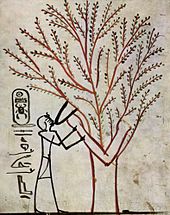Isched tree
| Isched in hieroglyphics | |||||
|---|---|---|---|---|---|
Isched Jšd |
|||||
| The sacred tree of Heliopolis with Seschat and Thoth while noting | |||||
The Isched tree is a sacred tree in Egyptian mythology . Like the sycamore , the ished tree was associated with the sun god and the horizon.
The tree in ancient Egypt
In ancient Egypt trees were a rarity. The species found included acacia , tamarisk , date and doum palms as well as sycamore, the mulberry fig . The tree itself was therefore something special and was probably therefore closely linked to various deities.
There are different hypotheses on the question of what kind of tree the Isched tree is. According to the representations, it is a deciduous tree, but it is not specified. Ian Shaw and Paul Nicholson name the Persea tree, while Rainer Hannig is considering the black breastberry tree , the Egyptian myrobalan tree or the Egyptian balanite tree .
The Isched tree in mythology
The Isched tree is associated with both the sun god Re and the deities of the writing arts, Seschat and Thoth . But other gods such as Re-Harachte , Ptah , Sachmet , Atum or Amun were also represented together with the tree. In connection with trees in general, these were the goddesses Nut and Hathor .
The Isched tree was considered "the holy Isched in the obelisk house at Heliopolis ", the city of the sun god. For example, after defeating his enemies, Re is said to have split the Isched tree one morning, which is a metaphor for the opening of the horizon gate and the sunrise. In Proverb 17 of the ancient Egyptian Book of the Dead it says:
"I am that big cat who split the Ished tree next to him in Heliopolis on that night of battle, of the imprisonment of the rebels, on that day when the enemies of the Almighty were destroyed."
In the 18th dynasty, the Ished tree came to mean a tree of life , as Seschat wrote the names and years of reign of the kings ( pharaohs ) on the leaves of the tree and thus the time of their reign was placed under the protection of the gods.
Representations of the Isched tree

The grave of Thutmose III. in the Valley of the Kings , KV34 , contains a drawing showing the king suckling from the Ished tree. The ished tree was not only a popular motif in the 18th Dynasty ( New Kingdom ), but also for temple decoration in the Ramesside period or later. A ceiling relief of the so-called “New Year's Chapel” in the temple of Dendera shows two isheed trees on each side of the rising sun. Also in the temple of Edfu there are depictions of the “holy Isheed tree on the side of the Re in the horizon of eternity”. In relation to the Osiris tomb, the Isched tree also appears.
literature
- Hans Bonnet : Tree cult. In: Lexicon of Egyptian Religious History. Nikol, Hamburg 2000, ISBN 3-937872-08-6 , pp. 82-87.
- Wolfgang Helck , Eberhard Otto: Small Lexicon of Egyptology. Harrassowitz, Wiesbaden 1999, ISBN 3-447-04027-0 , p. 46.
- Manfred Lurker : Lexicon of the gods and symbols of the ancient Egyptians. Scherz, Bern / Munich / Vienna 1998, ISBN 3-502-16430-4 , p. 107.
- Ian Shaw, Paul Nicholson: Reclam's Lexicon of Ancient Egypt. Reclam, Stuttgart 1998, ISBN 3-15-010444-0 , pp. 48-49.
Individual evidence
- ↑ a b Rainer Hannig: The language of the pharaohs. Large concise dictionary of Egyptian-German (2800 - 950 BC) . (= Cultural history of the ancient world . Volume 64). von Zabern, Mainz 2001, ISBN 3-8053-1771-9 , p. 106.
- ↑ Manfred Lurker: Lexicon of the gods and symbols of the ancient Egyptians. P. 107.
- ↑ Erik Hornung: The Egyptian Book of the Dead. Unchanged photomechanical reprint of the 1979 edition, Artemis & Winkler, Düsseldorf / Zurich 1997, ISBN 3-7608-1037-3 , p. 68.
